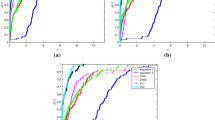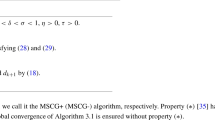Abstract
We propose a family of spectral gradient methods, whose stepsize is determined by a convex combination of the long Barzilai–Borwein (BB) stepsize and the short BB stepsize. Each member of the family is shown to share certain quasi-Newton property in the sense of least squares. The family also includes some other gradient methods as its special cases. We prove that the family of methods is R-superlinearly convergent for two-dimensional strictly convex quadratics. Moreover, the family is R-linearly convergent in the any-dimensional case. Numerical results of the family with different settings are presented, which demonstrate that the proposed family is promising.


Similar content being viewed by others
References
Akaike, H.: On a successive transformation of probability distribution and its application to the analysis of the optimum gradient method. Ann. Inst. Stat. Math. 11(1), 1–16 (1959)
Barzilai, J., Borwein, J.M.: Two-point step size gradient methods. IMA J. Numer. Anal. 8(1), 141–148 (1988)
Birgin, E.G., Martínez, J.M., Raydan, M.: Nonmonotone spectral projected gradient methods on convex sets. SIAM J. Optim. 10(4), 1196–1211 (2000)
Birgin, E.G., Martínez, J.M., Raydan, M., et al.: Spectral projected gradient methods: review and perspectives. J. Stat. Softw. 60(3), 539–559 (2014)
Broyden, C.G.: A class of methods for solving nonlinear simultaneous equations. Math. Comput. 19(92), 577–593 (1965)
Cauchy, A.: Méthode générale pour la résolution des systemes d’équations simultanées. Comp. Rend. Sci. Paris 25, 536–538 (1847)
Dai, Y.H.: Alternate step gradient method. Optimization 52(4–5), 395–415 (2003)
Dai, Y.H.: A new analysis on the Barzilai–Borwein gradient method. J. Oper. Res. Soc. China 2(1), 187–198 (2013)
Dai, Y.H., Al-Baali, M., Yang, X.: A positive Barzilai–Borwein-like stepsize and an extension for symmetric linear systems. In: Numerical Analysis and Optimization, pp. 59–75. Springer (2015)
Dai, Y.H., Fletcher, R.: On the asymptotic behaviour of some new gradient methods. Math. Program. 103(3), 541–559 (2005)
Dai, Y.H., Fletcher, R.: Projected Barzilai–Borwein methods for large-scale box-constrained quadratic programming. Numer. Math. 100(1), 21–47 (2005)
Dai, Y.H., Hager, W.W., Schittkowski, K., Zhang, H.: The cyclic Barzilai–Borwein method for unconstrained optimization. IMA J. Numer. Anal. 26(3), 604–627 (2006)
Dai, Y.H., Kou, C.: A Barzilai–Borwein conjugate gradient method. Sci. China Math. 59, 1511–1524 (2016)
Dai, Y.H., Liao, L.Z.: \(R\)-linear convergence of the Barzilai and Borwein gradient method. IMA J. Numer. Anal. 22(1), 1–10 (2002)
Dai, Y.H., Yuan, Y.X.: Alternate minimization gradient method. IMA J. Numer. Anal. 23(3), 377–393 (2003)
Dai, Y.H., Yuan, Y.X.: Analysis of monotone gradient methods. J. Ind. Manag. Optim. 1(2), 181 (2005)
De Asmundis, R., Di Serafino, D., Hager, W.W., Toraldo, G., Zhang, H.: An efficient gradient method using the Yuan steplength. Comput. Optim. Appl. 59(3), 541–563 (2014)
De Asmundis, R., Di Serafino, D., Riccio, F., Toraldo, G.: On spectral properties of steepest descent methods. IMA J. Numer. Anal. 33(4), 1416–1435 (2013)
Dennis Jr., J.E., Moré, J.J.: Quasi-Newton methods, motivation and theory. SIAM Rev. 19(1), 46–89 (1977)
Di Serafino, D., Ruggiero, V., Toraldo, G., Zanni, L.: On the steplength selection in gradient methods for unconstrained optimization. Appl. Math. Comput. 318, 176–195 (2018)
Dolan, E.D., Moré, J.J.: Benchmarking optimization software with performance profiles. Math. Program. 91(2), 201–213 (2002)
Fletcher, R.: On the Barzilai–Borwein method. In: Optimization and Control with Applications, pp. 235–256 (2005)
Frassoldati, G., Zanni, L., Zanghirati, G.: New adaptive stepsize selections in gradient methods. J. Ind. Manag. Optim. 4(2), 299 (2008)
Friedlander, A., Martínez, J.M., Molina, B., Raydan, M.: Gradient method with retards and generalizations. SIAM J. Numer. Anal. 36(1), 275–289 (1998)
Gonzaga, C.C., Schneider, R.M.: On the steepest descent algorithm for quadratic functions. Comput. Optim. Appl. 63(2), 523–542 (2016)
Grippo, L., Lampariello, F., Lucidi, S.: A nonmonotone line search technique for Newton’s method. SIAM J. Numer. Anal. 23(4), 707–716 (1986)
Huang, Y., Liu, H.: Smoothing projected Barzilai–Borwein method for constrained non-Lipschitz optimization. Comput. Optim. Appl. 65(3), 671–698 (2016)
Huang, Y., Liu, H., Zhou, S.: Quadratic regularization projected Barzilai–Borwein method for nonnegative matrix factorization. Data Min. Knowl. Discov. 29(6), 1665–1684 (2015)
Jiang, B., Dai, Y.H.: Feasible Barzilai–Borwein-like methods for extreme symmetric eigenvalue problems. Optim. Methods Softw. 28(4), 756–784 (2013)
Kalousek, Z.: Steepest descent method with random step lengths. Found. Comput. Math. 17(2), 359–422 (2017)
Liu, Y.F., Dai, Y.H., Luo, Z.Q.: Coordinated beamforming for MISO interference channel: complexity analysis and efficient algorithms. IEEE Trans. Signal Process. 59(3), 1142–1157 (2011)
Nocedal, J., Sartenaer, A., Zhu, C.: On the behavior of the gradient norm in the steepest descent method. Comput. Optim. Appl. 22(1), 5–35 (2002)
Raydan, M.: On the Barzilai and Borwein choice of steplength for the gradient method. IMA J. Numer. Anal. 13(3), 321–326 (1993)
Raydan, M.: The Barzilai and Borwein gradient method for the large scale unconstrained minimization problem. SIAM J. Optim. 7(1), 26–33 (1997)
Raydan, M., Svaiter, B.F.: Relaxed steepest descent and Cauchy–Barzilai–Borwein method. Comput. Optim. Appl. 21(2), 155–167 (2002)
Tan, C., Ma, S., Dai, Y.H., Qian, Y.: Barzilai–Borwein step size for stochastic gradient descent. In: Advances in Neural Information Processing Systems, pp. 685–693 (2016)
Wang, Y., Ma, S.: Projected Barzilai–Borwein method for large-scale nonnegative image restoration. Inverse Probl. Sci. Eng. 15(6), 559–583 (2007)
Wright, S.J., Nowak, R.D., Figueiredo, M.A.: Sparse reconstruction by separable approximation. IEEE Trans. Signal Process. 57(7), 2479–2493 (2009)
Yuan, Y.X.: Step-sizes for the gradient method. AMS IP Stud. Adv. Math. 42(2), 785–796 (2008)
Zhou, B., Gao, L., Dai, Y.H.: Gradient methods with adaptive step-sizes. Comput. Optim. Appl. 35(1), 69–86 (2006)
Acknowledgements
The authors are very grateful to the associate editor and the two anonymous referees whose suggestions and comments greatly improved the quality of this paper.
Author information
Authors and Affiliations
Corresponding author
Additional information
Publisher's Note
Springer Nature remains neutral with regard to jurisdictional claims in published maps and institutional affiliations.
This work was supported by the National Natural Science Foundation of China (Grant Nos. 11631013, 11701137, 11671116) and the National 973 Program of China (Grant No. 2015CB856002).
Rights and permissions
About this article
Cite this article
Dai, YH., Huang, Y. & Liu, XW. A family of spectral gradient methods for optimization. Comput Optim Appl 74, 43–65 (2019). https://doi.org/10.1007/s10589-019-00107-8
Received:
Published:
Issue Date:
DOI: https://doi.org/10.1007/s10589-019-00107-8




